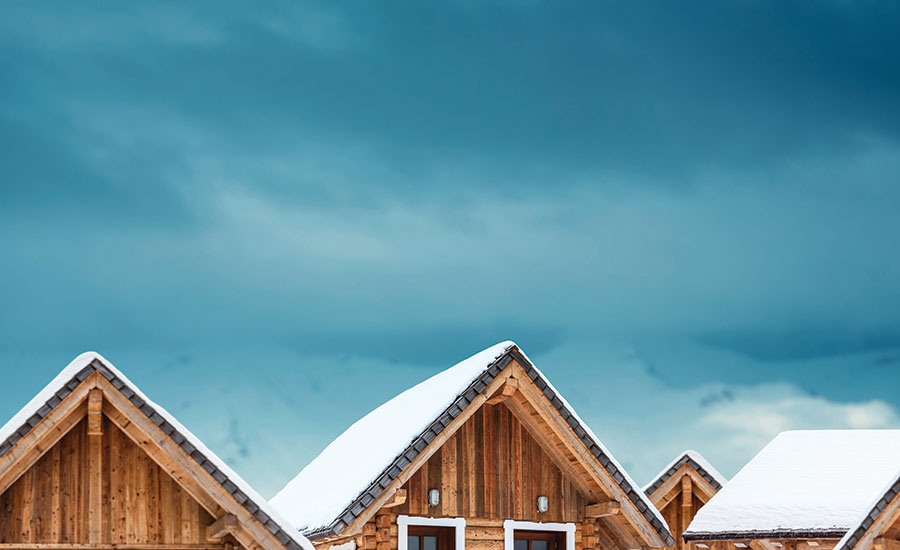Six Winter Safety Tips for Roofing Contractors




During the winter months, there are few workplaces more dangerous than the roof of a house. Those ill-prepared for the challenges of winter roofing projects risk both injury and death. Here are six things to keep in mind when roofing during the winter:
1. Hypothermia
Hypothermia occurs when a person’s core body temperature falls below the level required to keep the critical organs functioning. The two factors that promote hypothermia are low temperatures and moisture. Human perspiration in combination with winter cold conspire to conduct body heat away from a worker’s body when working on roofs.
The signs that a person has hypothermia include sudden drowsiness, shallow breathing and clumsiness. If you or anyone on your crew thinks someone has hypothermia, call immediately for emergency help, remove any wet clothing and get the individual to a heated area as quickly as possible. If a heated area isn’t close, cover the person with a dry blanket (wool or emergency Mylar blankets are the best).
When doing roof work in the winter, donning three layers of clothing is the best way to help a person’s body combat the dangers of hypothermia:
- An Inner Layer. The inner layer’s purpose is to take away body moisture.
- An Insulation Layer. Wool or goose down are the best material for insulation layers.
- An Exterior Layer. The final layer should be water resistant.
Also, be sure to always bring a change of clothes and a Mylar or wool blanket in the work truck, just in case you or someone on your crew catches hypothermia.
2. Frostbite
When your skin is not properly protected from the wind and freezing temperatures, frostbite can occur. The areas of the body most susceptible to frostbite for roofers are the ears, nose, fingers and toes. You will know when you have contracted frostbite because the affected part of your body will suddenly lose feeling and ultimately turn white, yellow, and, eventually, blue or black.
If you or a member of your crew gets frostbite, immediately raise the temperature of the body extremity in tepid water and call for emergency help.
3. Falls
Every roof job requires a protection plan. Use temporary rooftop guardrails to protect your crew from falls. Be aware, however, that fall-in-place accidents are more common, and typically happen when workers change direction or change a method of access (from a ladder onto a roof, for example).
Be sure to check your work ladder for ice. Sometimes a roofer will slip on an icy ladder rung and injure themselves before they even make it to the roof.
Also, when using a ladder, always employ the “three-point rule.” This rule simply states that a roofer should have at least three points of contact with the ladder at all times. Two feet and one hand or two hands and one foot are both acceptable configurations when using a ladder in winter.
4. Winter Driving
Don’t forget to consider work-related travel hazards. Providing roofers with a defensive driving course is always a good idea. You will get an insurance break, and will know with confidence that your crew will be trained in winter driving techniques. If at all possible, don’t do roof work in temperatures below 40 degrees. This will help to avoid material failure, wasted labor and potential injury.
5. De-Icing and Snow Removal
Always use a trained crew for removing ice and snow before your team accesses the roof. If the people repairing the roof also do the snow and ice removal, they may overlook their own safety and focus on completing the repairs.
When it comes to removing ice from the roof, de-ice with salt. Be positively certain all snow is also removed, since stepping on snow, even on a flat roof, can rapidly make a worker lose their center of gravity and slide.
Another snow danger is its capacity to conceal roof parts from your work team. For example, even a light snow drift can hide a skylight or other roof opening, which can result in a worker falling through and damaging both themselves and the roof.
6. Dehydration
Roofers need a rehydration plan, yet few incorporate one into their daily routine. Some of the key elements of this plan will be the following:
- A morning stretch before working, which includes at least 16 ounces of bottled water. Anything less than 16 ounces of water risks possible dehydration.
- Monitoring urine color. If your urine is darker than normal, that indicates a person has low kidney filtration and needs to hydrate.
- Eat more fruit and vegetable snacks. The added moisture in fruits and vegetables will help stave off dehydration.
- Have a thermos full of hot chicken or tomato soup during a break. Unlike a sandwich, these liquids are not only tasty, they will keep you and your crew hydrated.
- If you plan to have a few beers after work, chase each beer with a glass of water. It’s okay to grab some brews with your team, just be sure to hydrate as you go.
- After you have your two cups of coffee in the morning, avoid it for the rest of the day. Coffee is a notorious diuretic. Steer clear of it while doing outdoor winter work.
Staying safe on rooftops at any time of the year should always be a top priority. In winter, however, its importance becomes much more critical. Follow these tips, and you’ll cut your risk considerably.
Looking for a reprint of this article?
From high-res PDFs to custom plaques, order your copy today!










